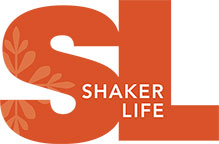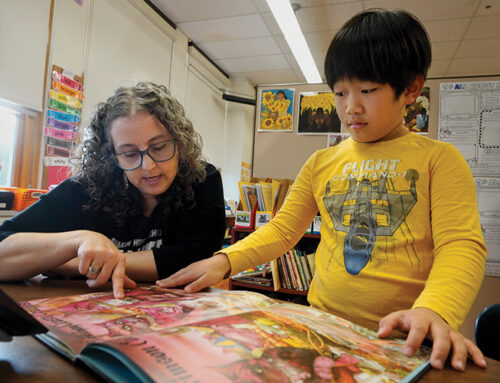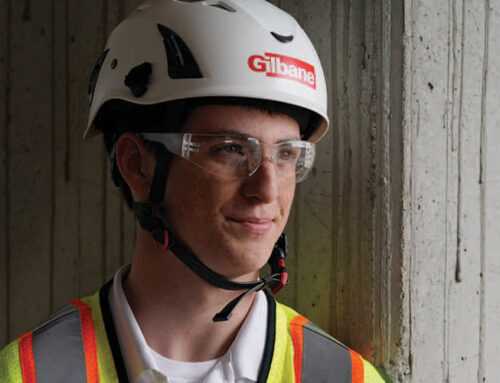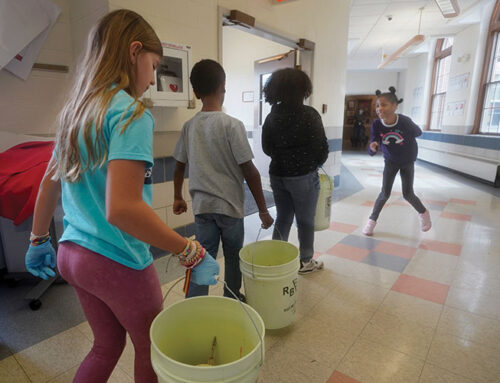Shaker Heights Schools’ i3 Initiative develops students’ entrepreneurial skills by pairing technology with opportunities to problem-solve and think critically.
By Jennifer Kuhel
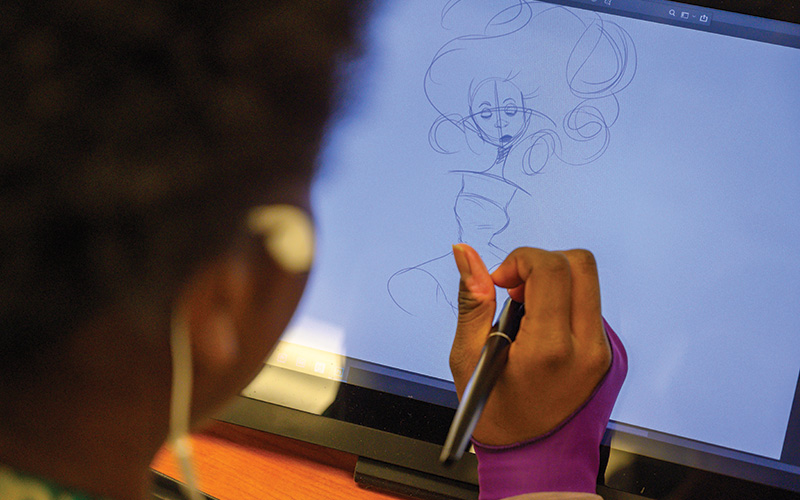
Photography by Jason Miller.
Do a Google search on whether entrepreneurs are born or made and you’ll get a list of magazine articles and scholarly research that consider the merits of one or both. But for Shaker Heights Schools, the matter isn’t up for debate: The District has placed a premium on ensuring that students have opportunities to develop their entrepreneurial skills, regardless of whether they plan to be the next Bill Gates. That means developing critical thinking skills, encouraging students to think creatively, building problem-solving skills, and working collaboratively.
“There’s so much research that shows that the jobs we have today are not going to exist when the students we have today are entering the workforce,” says Lauren Priestley, the District’s Curriculum and Instruction Technology specialist. “We’re at a time now where education is moving less toward memorizing and learning what already exists; there’s more emphasis on students creating the processes and solutions for problems that interest them.”
The District believes the powerful combination of its PreK-12 International Baccalaureate Programme along with its new i3 Initiative – which provides students with more design learning experiences, accessibility to today’s leading technology and tools, as well as a Science, Technology, Engineering, Arts and Math (STEAM) curriculum – will prove to be beneficial to all students in the years ahead.
“The goal is to have i3 touch every student and to find multiple ways to engage them in these opportunities,” says Holly Coughlin, executive director of the Shaker Schools Foundation, the District’s primary funding partner for i3. The District and the Foundation together have granted nearly $437,000 to support projects at all levels within the District. The funding has been responsible for the construction of a new makerspace at Woodbury Elementary School, STEAMrelated professional learning opportunities for staff at the elementary schools and Shaker Heights Middle School and, at Shaker Heights High School, new state-of-the-art equipment in arts classrooms, as well as a new advanced robotics and manufacturing course.
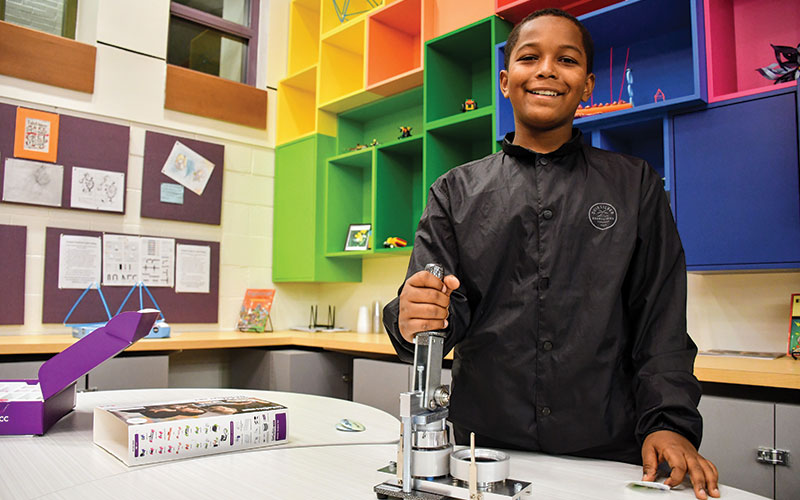
DJ Washington, in the Woodbury Makerspace, with the button maker. Photo courtesy of Jen Kuhel
Sparking Entrepreneurial Skills
Shaker Heights Schools students in all grades have multiple entry points for developing their entrepreneurial and problem-solving skills, thanks to IB and i3. This year at Woodbury, for example, students can visit the library’s new Makerspace during recess or after school, where they have the option to build with LEGOs, program and control a Sphero robot, or code a path for a small Ozobot robot. Woodbury students also participate in a special design class once every five days that focuses on the elements of digital design and product design. In this class, students use the design cycle to analyze challenges, develop and create feasible design solutions, and evaluate prototypes, products and systems.
But not all learning tools that cultivate entrepreneurial skills are necessarily as high-tech as a robotics kit. For Woodbury sixth-grade student DJ Washington, an encounter with the school’s new pinback button-maker (also purchased with grant money from the Innovation Fund), was the gadget that got his creativity flowing. DJ recalls the day that his art teacher, Deanna Clemente-Milne, asked him to stop by her art room after school. “I thought she was going to have me do something with clay,” he admits.
Instead, Clemente-Milne produced the pinback button maker, the kind that makes round buttons students typically pin to jackets, backpacks, and lunch bags. She asked him if he’d like to help her make some. DJ got to work and the very first button he created had a simple message on it: We are strong as one.
“I liked the message because it was something that worked for everyone,” says DJ. “You could give it to a staff member, you could give it to a friend, you could give it to your mom. Because everything you do in life, you have to do as one team.”
A few buttons later, DJ had another idea. He asked Clemente-Milne if he could make buttons to sell at the Woodbury WPBS store, a lunchtime store that sells prizes in exchange for tickets students earn by displaying positive behaviors. Clemente-Milne loved the idea, and, in fact, it was precisely what the Woodbury i3 team had hoped would happen.
“We wanted to get the button maker because it’s an accessible entry point for kids to test their entrepreneurial skills,” says Woodbury Librarian Rob Kaminski. Kaminski is also part of the team that leads the school’s new Makerspace. “It’s something that kids can pick up on pretty easily and, if they connect the dots on what’s possible when they make a button, then they can go even further.”
In DJ’s case, he created a Google Slides presentation and shared his idea with the Woodbury WPBS committee (an “all grown ups” committee, he notes). He explained his idea, shared his pricing structure, did a product demo, and earned the green light to move his idea forward.
Today, DJ says he’s more than a student. “I’m an entrepreneur,” he says proudly. “That means that I’m a risk-taker, but I’m also a thinker, communicator, and I’m responsible.”
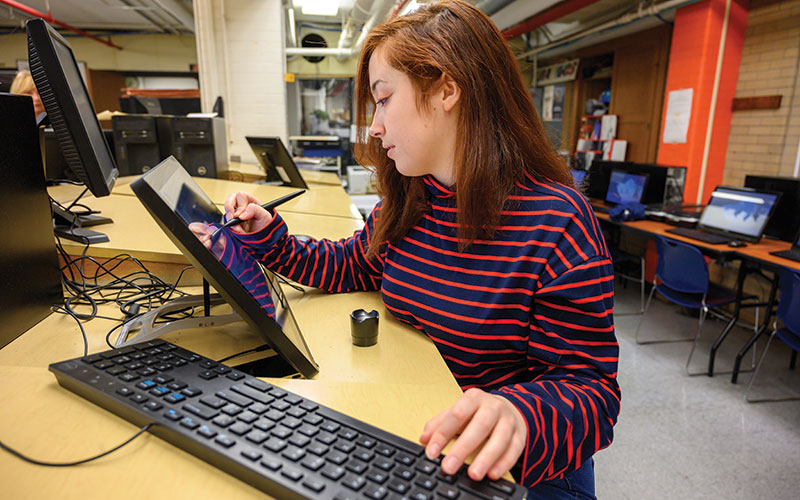
Grace McCormack works on a Huion tablet in her Digital Multimedia class.
The Tools for Today and Tomorrow
This year, thanks to i3 investments in advanced art equipment at Shaker Heights High School – specifi cally Huion Tablets, camera and video equipment, and a programmable sewing and embroidery machine – students in digital design and portfolio classes say they now have the classroom experiences and industry-standard tools that will give them the skills they need to compete in the workforce.
“The emphasis on entrepreneurial skills is very serious now,” says High School Digital Design Teacher Keaf Holliday. “We’re trying to teach kids that if they can start honing in on their graphic and digital design skills here, then they’ll be one step ahead of everyone else.”
Shaker Heights High School junior and Digital Design student Abigail Walicke took Holliday’s advice to heart. Last year, during Holliday’s unit on branding, in which students have the opportunity to redesign logos and branding materials for local businesses, Walicke worked with a local yoga studio.
“It was great to have this experience where I met with the owner and she told me what colors she liked and what design elements she wanted,” Walicke remembers. “I was able to learn more about what it’s like to design for a client and what that process would be like in the real world. I’m literally learning in class and getting work experience at the same time.”
And this year, Holliday’s room has been outfitted with 25 new Huion tablets, which enable students to draw directly onto a monitor and see their designs as though they were drawing on paper. Previously students drew on a tablet that displayed their work on a screen, something that took some getting used to and could be cumbersome.
“These tablets enable us to work on the same equipment we’d be working on if we were out in the world right now,” says Shaker Heights High School senior and award-winning art student Grace McCormack. “The graphic design program here has been very clear about being as industry-standard as possible and now, with these tablets and all of our illustration and animation software, we’re there.”
This year, Grace used the Huion Tablets to design a set of printable stickers featuring Corgo, an illustrated Welsh Corgi character she created. And now that her designs have been captured with better technology, she’s been exploring copyright options and building out a website so that she could sell items with the Corgo image.
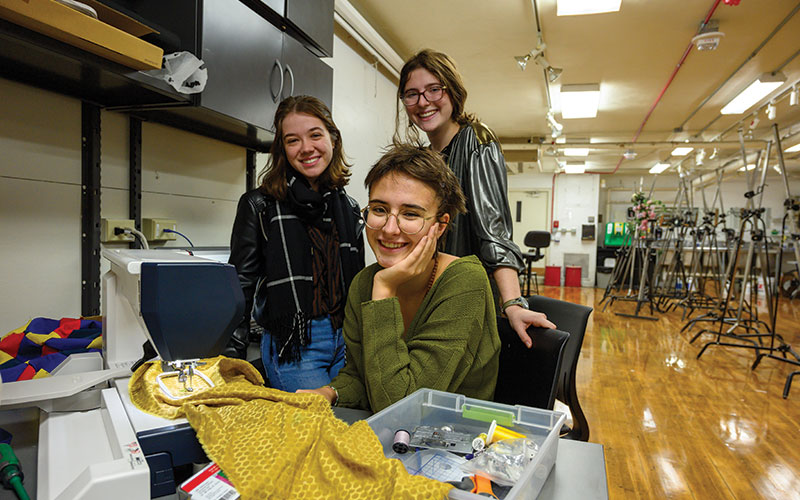
(Above, left to right) Lane Murray, Louise Spadoni and Rachel Raddock purchase clothing from thrift stores, embellish them with this special sewing machine, and resell the items for their business, CyCLE Clothing. One hundred percent of the profits go to charity.
Seniors Louise Spadoni, Rachel Raddock, and Lane Murray say that the new sewing and embroidering machine dovetails well with their IB Diploma Programme Community Service Project, CyCLE Clothing, a nonprofit upcycled clothing business. The trio inherited the business from recent graduates who had been reselling thrifted clothing.
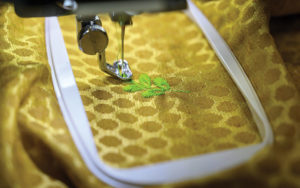
An embroidery detail on one of Louise Spadoni’s designs.
But they took the idea one step further: They’re using the new sewing and embroidery machine to embellish or alter thrifted items, making them one-of-a-kind before a resale, and they donate 100% of their proceeds to charity. Previously, Louise had been doing most of the stitching and embroidery by hand.
“This is so much faster and you can make nearly perfect designs so that it looks like something you could buy in the store,” she says.
Skills for the Future
Perhaps the biggest champion for the District’s i3 Initiative is a group of more than 30 community members and local business leaders who serve as members of the i3 community advisory council. Among them is Heather Stefanski, a Shaker Heights High School graduate who returned to Shaker Heights from California in 2018 with her husband, Ben, who is also a Shaker Heights High School alum, and their two teen-aged sons, Ben and Luke.
In California, Stefanski’s eldest son Ben had been enrolled in an engineering academy, where much of his learning was project-based and collaborative. The couple intentionally enrolled Ben in that school, as Stefanski knew from her graduate work in business and education at Stanford University that the skills he would gain at the engineering academy were the skills he would need in the future. She saw the positive impact that learning environment had on her son and began to work with the i3 Initiative to incorporate elements of her son’s experiences here.
“This is a big shift for Shaker, but it’s an exciting shift. And we need to keep developing this path for kids who want to build and invent and create just as much as we develop a path for kids who want to go a more traditional route,” Stefanski says. “If we can pull all of this off, then Shaker can truly be cutting edge.”
